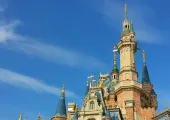Top 8 Things to Know about Manhattan Bridge
Contents
- A Brief History of Manhattan Bridge:
- A Connection Between Brooklyn to Manhattan:
- Can People Walk Through Manhattan Bridge?
- Other Bridges Between Brooklyn and Manhattan:
- The Brooklyn Bridge:
- The Williamsburg Bridge:
- The Queensborough Bridge:
- The Verrazano-Narrows Bridge:
Show more
The 1909 century-old suspension Manhattan Bridge effectively connects Brooklyn to southeastern lower Manhattan areas while bridging the East River. And, what a stunning view you can get of the New York Harbor and some of the other NYC bridges! Come let us visit the bridge on foot and discover all that you need to know of the Manhattan Bridge to make your experience of the bridge unique and satisfying. Treat this as a walking tour New York bridges guide if you will because it tells you how to best access the popular bridge, tidbits about its history, art connections, subway, its bridge connection from Brooklyn to Manhattan and the unique architecture that will surprise you.
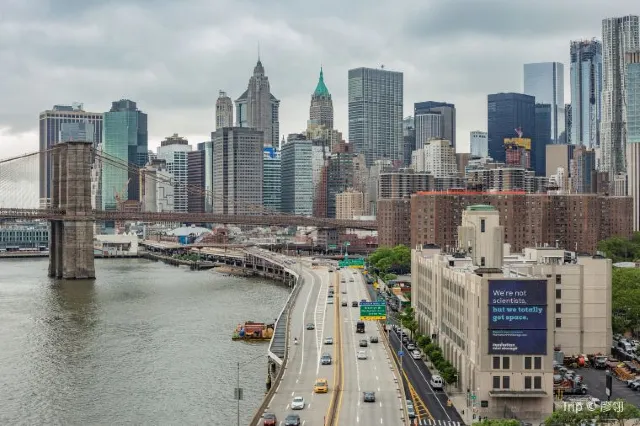
The steel-towered construction of this star and youngest of the three New York bridges started off in 1901, took 8 years in its making and was thrown open to the public in 1909 on the auspicious New Year's Eve. Want to know a bit about its awesome numbers? The bridge is 6,855 ft long if you include the approach with a span of 1,450 feet, a height of 336 ft at its towers and an actual traversable width of 150 ft. The central portion is 135 ft above the mean water levels and it cost about 31 million USD as reported in 1909. Here’s an awesome fact; on weekdays, an estimated 450,000 persons cross the Brooklyn to Manhattan Bridge albeit using the subways, so it's quite common to be on the NYC bridges.
It is the fourth of the five New York bridges connecting Manhattan and Long Island and the third of the three bridges between Manhattan and Brooklyn today spanning the East River. It followed the 1883 Brooklyn Bridge and the 1903 Williamsburg Bridge. The most recent one to connect Brooklyn to Manhattan is the 1964 Verrazano-Narrows Bridge.
Its design ran into controversy as it had the then-new concept of engineering’s "deflection theory," propounded by the Austrian Joseph Melan as its base. Chief Architect Gustavo Lindenthal should be credited for its design for “Suspension Bridge No: 3” of the New York bridges, which was reworked by him with the existing “eye-bar/suspenders” plan. Did you know that then people wanted to name it “Wallabout Bridge” after the nearby Bay? Of course, it was named officially as Manhattan Bridge in 1902.
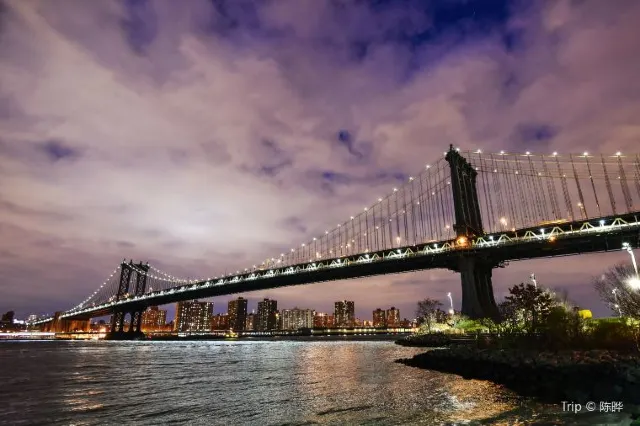
Part of the radical Lindenthal’s eye-bar plan and design was to use two-dimensional tower profiles with four columns to a tower, resulting in less design rigidity and providing for more expansion, contraction and flexibility of the by then standardized suspension bridge replicated in Brooklyn and Williamsburg. The trendsetter among NYC bridges was initially to have diagonal cable stays and suspender vertical ropes but the engineers Leon Moisseiff and Othniel Foster Nichols went with traditional wire-spun cables supported by the 322 ft towers to incorporate both the design concepts and the deflection theory itself. This theory meant that the three forces of the roadway load acting downwards, the upwards pulling component acting to the left and its other upward pulling component to the right were all accounted for. The bridge also featured the Brooklyn to Manhattan subway service with its trains starting operations in 1915. The two identical roadways were 1922 additions for trolleys and became motorways in 1929.
Since then the Manhattan Bridge has needed repairs and major upgrades in 1940 and in 1990 when the re-routing of the subways through tunnels occurred, the plaza was restored and the walkways on the south and north were removed in the 1960s. Did you know that the bridge to Brooklyn is among the NYC bridges which caused the then under-developed Brooklyn area to develop suddenly because of its accessibility by road from New York City?
You can use the Brooklyn to Manhattan motorway above, the subways across or even walk, cycle across and run to your customized view for inspiration. Today, the south walkway reopened in 2001 is for pedestrians and the north for bicyclists for traversing the Brooklyn to Manhattan route. The Manhattan Bridge walk may not be as spectacular as Brooklyn Bridge’s but is none the lesser as it has the same skyline NYC bridges view as well as the fantastic view of the Brooklyn Bridge as you walk or cycle past. The 7-laned double-deck motorway has 4 lanes atop and three reversible lanes below handling up to 80,000 cars crossings every day with zero tolls. The lower-level also accommodates the four #B, #D, #N and #Q subway train lines.
Besides the connectivity let us not forget the historical and inspirational history, art connections and developmental strategies that also link Brooklyn to Manhattan.
But from where can one access the Manhattan Bridge? The Manhattan Bridge can be entered from Chinatown’s Canal Street or its subway station and bus stops. If you are walking then you need to use the pedestrian entrance on Forsyth Street and Canal Street junction. If on a bicycle then you will use the Bowery Street using the detour from Division Street. The approach to the bridge has a stone archway called the plaza which has been there since 1915 and was restored recently in 2001. It was inspired by the NYC bridges, the Roman’s St Peter’s Square and the Parisian Porte St. Denis and designed by the Architects Hastings and Carrère.
Walking is the best exercise you can get across the NYC bridges. If not ride a bicycle from Brooklyn to Manhattan since the 1909 Manhattan suspension bridge has a dedicated pedestrian walkway, four subway lines, a bike lane and seven lanes for automobiles. The pedestrian pathway ends in Chinatown not far from where the spot where the Brooklyn Bridge enters Manhattan near the City Hall. It does get crowded on weekends but the weekdays are relatively free. Your entrance is on the southern side. The southern side reopened in 2001 while the northern end took 3 more years and has chain-linked high fences which were not in the Bernice Abbott’s 1930 photos drawing ire from the Manhattan residents as it affected the views.
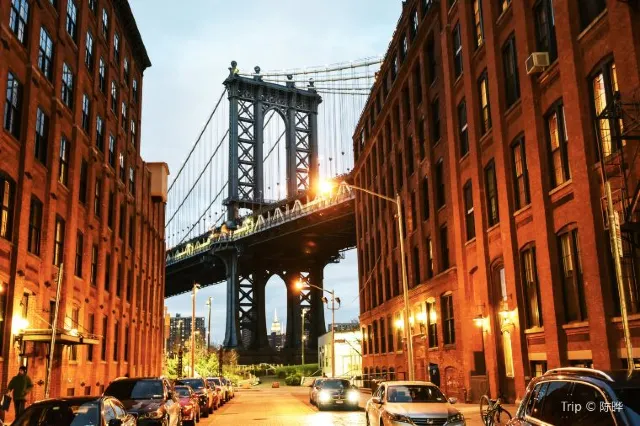
The South-Side walkway: From here if you turn and look backwards you will see the New York skyline, the Statue of Liberty, Brooklyn Bridge and New York Harbor. The renovation from 1982 has refurbished the walkway which was reopened in 2001.
Biking from the northern end: The northern-side bicyclist-entry lacks the typical magic of Manhattan views as its view is not as dramatic as those of the other bridges. Bicyclers miss the scintillating New York skyline-views because of the walkway’s location.
Your bridge viewing experience: This experience can vary across NYC bridges since the walkway of the Brooklyn to Manhattan bridge is fenced in on both sides by heavy metal mesh and your experience varies depending on the number of people on the walkway. Besides, the walkway is placed below the bridge. Off-hours are relatively unsafe and the experience of having the cars and subway movement atop can be a loud, no-nonsense way of getting to Brooklyn rather than the pleasant viewing experience it is expected to be. The views from the Brooklyn Bridge hog the limelight while the width of the Williamsburg bridge’s pedestrian path is wider and can accommodate more.
Subway on the bridge:On either side of the bridge are the identical roadways common to all NYC bridges and just atop the subway level. The motorways were initially used as trolley ways till 1929 when the motorway was introduced instead. However, the subways have been around since 1915 and comprised of the north-tracked presently Line #N Sea Beach Line to Chambers Street station and the present Line #R or BMT 4th Avenue to Nassau Street and the present #M and the #J lines. After redesigning the #D and #B lines, they were introduced as the lines truncating from the 6th Avenue and Nassau Streets. This is perhaps the most popular mode of transportation between Brooklyn to Manhattan today.
Manhattan Bridge and Charles Cary Rumsey: If you look to the top of the plaza arch you will find the famed sculptor Charles Cary Rumsey’s frieze popularly known as the ‘Indians hunting Buffalo’ complete with a keystone shaped like a buffalo head. It is paradoxical that the design by Carrere and Hastings for two of the best NYC bridges uses the old western Rumsey’s sculpture as its keystone for a bridge that spans Brooklyn to Manhattan and the East River while actually pointing to Manhattan’s East.
Artwork inspired by Manhattan Bridge: The Manhattan Bridge has a long art-connection. Drawing inspiration from sources like the previous suspension NYC bridges at Williamsburg, Brooklyn, Queensborough and the Triboro its Arch of Triumph or the plaza entrance was completed by the architects of the New York Public Library at W-42nd Street and Fifth Avenue. Thomas Hastings and Carrere were also inspired by the Vatican City’s St. Peter’s Church, the Parisian arch at Porte St.-Denis and the Colonnade of Giovanni Bernini. Through the sculptures of Carl Augustus Heber are set to display the Northern-end’s Spirit of Commerce and the Southern-end’s Spirit of Industry.
Attractions in Manhattan Bridge:Did you know that the Manhattan Bridge just recently celebrated it's century-plus a decade of being open to the public on the eve of New Year 1909? One of the most exciting attractions travelling from Brooklyn to Manhattan is the sway of the Manhattan Bridge caused by an engineering fault. Did you know that the bridge actually dips 4 feet on either end if two trains cross each other at the midway? A whopping 920 million USD has been spent on correcting the flaw and reinforcing the structure since the 1980’s when traffic on the bridge became an all-time high. The defect exists till date and can be felt if the #Q and #B lines trains cross each other mid-way of this strange and odd among NYC bridges.
The next feature that you must notice is that the official color of the bridge which was grey, was changed to the NYC bridges trademark and popular “Manhattan Bridge Blue”. It was hoped that the bridge would work its magic for Manhattan as the Brooklyn Bridge did for Brooklyn. The representation of the aim was set out in two lady-sculptures, the Spirits of Industry and Commerce designed by Daniel Chester French and representative of the facing of the two New York bridges. The statues on the Brooklyn to Manhattan directions were removed to the Brooklyn Museum due to congestion post-repairs. The ones installed now are replicas of the sculptures.
Manhattan Bridge is very visible in movies like Steve Martin’s “The Lonely Guy”, Will Smith’s “I Am Legend”, and the James Woods and Robert De Niro’s “Once Upon A Time In America”. It is also the subject of Edward Hopper’s 1928 painting called “Manhattan Bridge Loop”.
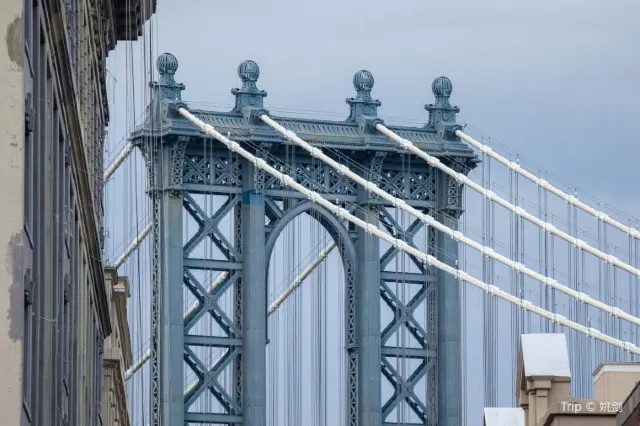
Have you forgotten that New York City is actually a conglomeration of islands divided into five boroughs that are interconnected by nearly 2,000 tunnels and New York bridges? The Manhattan Bridge is no doubt an engineering marvel with a history of NYC bridges that not only provide a connection from Brooklyn to Manhattan but also has an exceptional view to behold no matter how you travel. Now let us explore the other bridges between NY’s Brooklyn to Manhattan daily sojourns.
Famous for its view, Brooklyn Bridge is a landmark among the New York bridges. Used by over 4,000 global people each day, it served as an inspiration for the Manhattan Bridge and predates it historically to 1883. Noteworthy is the fact that since the time, it was built for Brooklyn’s population, popularity and economy which later went from from being underdeveloped to a super-city today! It is a traditional steel-wired suspension bridge with broad stays and 3D granite towers. The Manhattan Bridge of the period was built using the deflection model and has 2D towers and lacks the broad lateral stays. It has the longest history that dates it to the 1800s while spanning the River East connecting Brooklyn to Manhattan. It took 600 workers, 15 million USD and 14 years to finish the 6,000 ft long bridge!
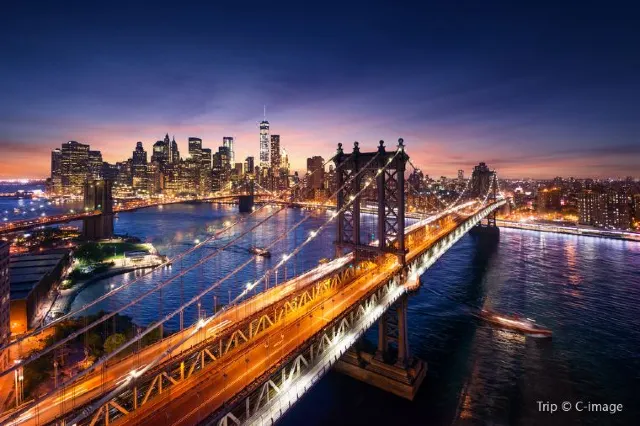
Just walk or ride a bicycle to get the best views of the NYC bridges and the skyline. The entrance on the Manhattan-side is located at Center Street and Park Row just east of the City Hall. On the other end, the entrance is at East of the Cadman Plaza at the junction of Boerum Place and Tillary Street. Expect it to be crowded all the time because of its stunning views, people taking pictures. Do remember to stay in your lane!
The 1903 Williamsburg Bridge precedes the Manhattan Bridge and was the world’s longest among New York bridges suspension bridge using steel towers to bridge the East River between Brooklyn and Manhattan. It was built to accommodate the traffic generated after Brooklyn’s growth made the traffic on Brooklyn Bridge impossibly chaotic. Did you know that horses and carriages were provided lanes for travel since the automobiles came only in 1915?
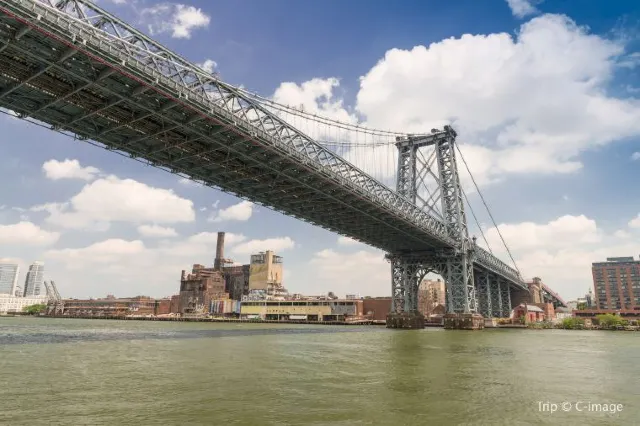
Inspired by the French Eiffel Tower this bridge connects Lower East of Manhattan to Williamsburg. Both biker-paths and pedestrian paths are present and separated from each other. It also has the #J, #M and #Z lines of the subway passing through it which is the most popular transport means followed by taxis when crossing the bridge. The entrances to the bridge lie at Delancey and Clinton Street if you are on the Manhattan side and between Berry Street and the S-6th and 5th streets if you are on the Brooklyn side. This area in Brooklyn is home to some popular hotels like William Vale and the Hoxton which offer rooftop bars with free scintillating NYC bridges views.
The Queensborough or 59th Street Bridge is used to travel between Queens and Manhattan and hence the name. Built in 1909, this gem amid the New York bridges uses steel weighing 75,000 T and is the most load-bearing bridge of the US. Its original structure included a car elevator to the middle of the river Roosevelt Island and a trolley line that transported people to Flushing, Astoria and Queens itself. Today it mostly connects Manhattan to the Queens area. Look and view this bridge as you travel to Manhattan from the LaGuardia or John F Kennedy Airports. While crossing the bridge, do look backwards for the exemplary view of the mid-town Manhattan horizon view.
The bridge is 0.75 miles long and great for a short walk or ride from where you get to see the views of both of the NYC bridges, the UN headquarters, the upper east side of Manhattan City, Long Island and the East River. The entrance on the Manhattan side for walking lies at E-60th Street between the Second and First Avenues. From the Queen's side you can use the entrance at Queens Plaza North and Crescent Street.
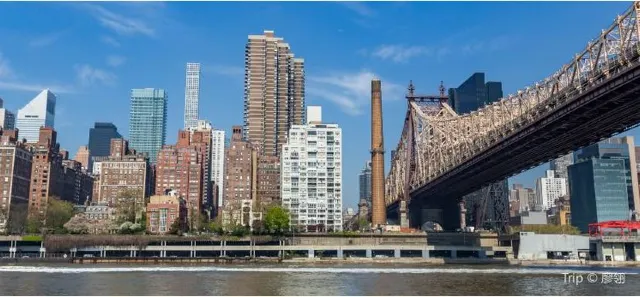
This youngest bridge of the New York bridges was constructed in 1964 and is visible in the distance from the Manhattan Bridge. At one time the Verrazano-Narrows Bridge was the then-largest suspension bridge in the world.
In parting, we hope you had a good walk or ride across the Manhattan Bridge. We have explored your options of viewing the finest of New York bridges and hope to have satisfied your curiosity about the bridge’s history and its construction details. Having set the right expectations for NYC bridges and armed with this knowledge we hope to see you explore the Manhattan Bridge which is among the foremost of NYC bridges spanning the distance from Brooklyn to Manhattan. Have a good time as we say bye for now!
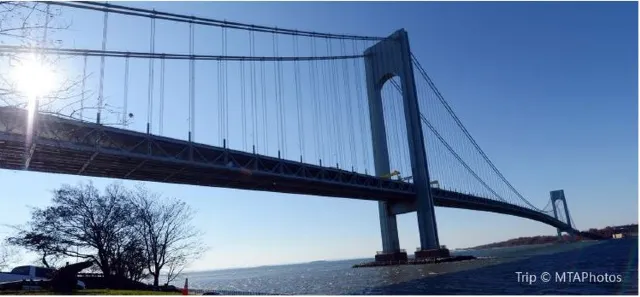
Trending Travelogues
Popular Trip Moments
Popular Attractions
Popular Ranked Lists
Popular Destinations
Recommended Attractions at Popular Destinations
About





of the year 2025
Site Operator: Trip.com Travel Singapore Pte. Ltd.


